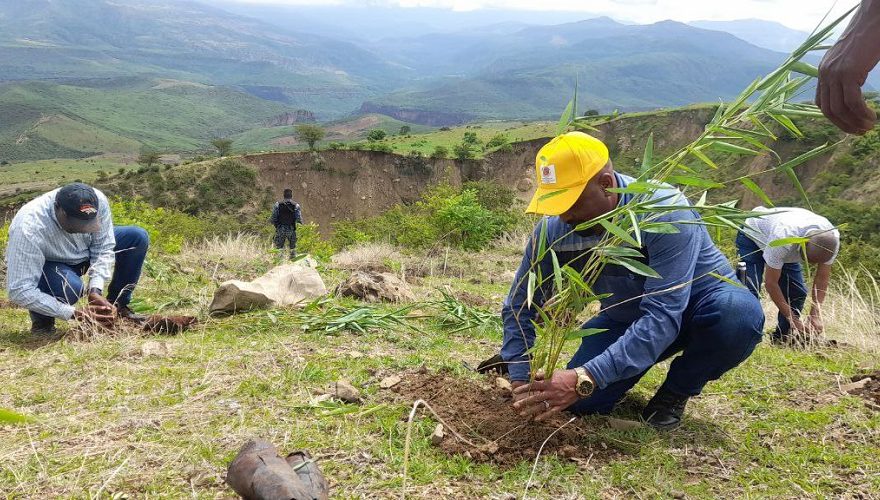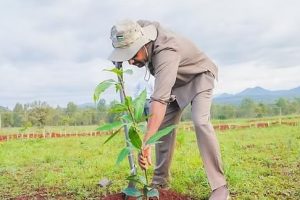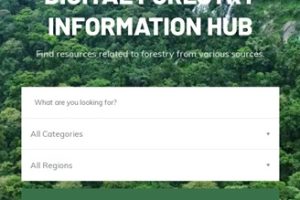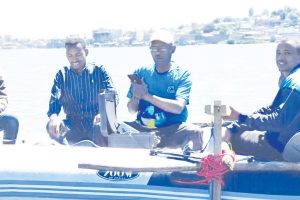
BY DARGIE KAHSAY
Following the launching of the construction of the Grand Ethiopian Renaissance Dam (GERD), the government of Ethiopia has launched environmental protection in the surroundings of Nile Basin including the valleys and tributaries of the Blue Nile River to protect the dam from unnecessary saddle impact and to maintain the sustainability of the ecology of the water sources of the River.
The project was officially started in 2021 by Ethiopian Forestry Development (EFD), Selale University and Debre Marikos Universities jointly. It aims to invest in bamboo development in the Blue Nile water sources and the valleys surrounding the tributaries of the River mainly to conserve the ecology of the area.
Along with the construction of the Dam, protecting the environment and keeping the sustainability of the ecology of the basin is a serious national issue. By mobilizing millions of farmers in the surroundings, Ethiopia has been investing highly in conserving and protecting the area plus recovering degraded and deforested areas of the Blue Nile Basin and valley areas during the past ten years.
In late 2021, The Ethiopian Herald approached Project Management, Environmental Protection and Art Affairs Director with Office of National Council for the Coordination of Public Participation on the Construction of the Grand Ethiopian Renaissance Dam (GERD), Solomon Teka, with regard to the efforts in conservation and protection of the environment of the Blue Nile basin area.
He said that, to maintain the sustainability of the water flows of the Nile River by conserving the nature and ecology of the water sources and to protect the nation’s giant power plant dam, GERD, from unnecessary sand, Ethiopia started reforestation, environmental protection and basin development strategies across the Blue Nile basin and the potential water source areas.
For Solomon, following the commencement of the construction of the GERD, Ethiopia gives attention for the development of this basin especially since 2013. Since the topography of the water sources of the Blue Nile is mountainous, densely populated and suitable for agriculture, the area was degraded, deforested and the water origins are affected which needs recovery mechanisms.
Considering this in mind, the director stated, for the last eight years, annual environmental conservation mechanisms were implemented including huge seedling plantation in the river basin and surroundings. During these years, Solomon said, farmers and pastoralists in three regions, Amhara, Oromia and Benishangul Gumuz, implemented huge land conservation mechanisms during January and February. During these years, the peoples’ in kind contribution in the conservation was over 121 billion birr.
Now, the national attention to conserve, protect, recover and reforest the Blue Nile water sources and valleys attracts the attention of institutions to implement research based projects to support the country’s efforts. In this regard, the Lowland Bamboo Development Project, launched by Selale, Debre Markos Universities jointly with Ethiopian Forestry Development targets environmental recovery and reforestation strategy through huge lowland bamboo tree plantation, started in 2021.
During the first year of the project, i.e., the 2021 plantation season, the joint institutions have planted over 250 thousand seedlings of bamboo tree in the area. Similarly, during this year’s rainy season, the joint institutions are planting new bamboo seedlings targeting to plant over 200 thousand lowland bamboo trees.
Attending the first round of this season’s bamboo seedling plantation in the area, Ethiopian Forestry Development (EFD) Deputy Director-General, Motuma Tolera (PhD), said that the Blue Nile valley lowland bamboo development project is among the major projects of the institution. The first round for this year’s lowland bamboo seedling plantation in the project was started in the sidelines of the river basin in North Shewa zone of Oromia State, Girar Jarso district and Eastern Gojam Zone of Amhara State, Dejen district, according to EFD.
Speaking to the media last week, Debre Markos University President, Tafere Melaku (PhD) said that, the university is actively participating in community service to support the people of the area. The Abay (Blue Nile) valley lowland bamboo development project, jointly with Selale University and EFD, is one among the university’s community service projects, he added.
For Tafere the area is suitable for bamboo development and investing in developing bamboo in the area will have double benefits, for environmental conservation and to develop commercial forests. Bamboo is suitable for soil conservation and easily expanding itself, which is helpful to reforest the affected area of the Blue Nile basin and the valleys. In addition, since bamboo is the most important tree for industrial inputs, especially for furniture sector. Hence, he said, by investing on bamboo development, the project aims to increase the forest coverage of the area for environmental protection purpose and to increase commercial trees.
EFD stated that during this year’s bamboo seedling plantation in the area, the staff of the three institutions and people of the community were participated. EFD noted that, the project is being implemented by the three institutions with the support of the Government of Sweden and EFD underlines that the Abay valley lowland bamboo development project is among the key national projects under the institution.
According to experts from EFD, the Abay valley bamboo development project was started to conserve the soil from erosion, to conserve the ecology of the area especially in the Abay Bereha area which is more vulnerable for soil erosion and over flood. In addition, the area is losing its forest coverage and the lowland bamboo development project aims to recover the area’s forest coverage. According to EFD, the growth of the last year planted bamboo seedling in the area is on good development and the plantation continues this season.
Researcher in Forest sector, Adefris Worku (PhD) told ENA that bamboo is the best plant to protect the ecology of the Abay valley. An expert with EFD, Adugna Admas, also shares Dr. Adefris’ idea on the necessity of bamboo to protect the ecology and environmental conservation of the topography of the Abay valley. For the experts of the forest sector, lowland bamboo has the capacity to recover and conserve a degraded area and protect the ecology within short period of time. For the experts, lowland bamboo grows within three to five years and once fully grown, the plant can duplicate itself with its roots. This makes it preferable to grow the plant for commercial purposes.
Bamboo has the capacity of balancing weather condition; mainly bring coldness, in lowland areas. Not only that, the experts added that, bamboo’s nature is suitable for soil conservation and environmental protection. Considering the multidimensional benefits of the plant, the two higher education institutions jointly with EFD designed the Abay valley lowland bamboo development project so as to reforest and recover the affected and degraded area as demonstration. EFD praises the projects progress, though on its initial phase.
Deputy Director of EFD, Motuma Tolera (PhD), underlines that the Abay Valley lowland bamboo development project is among the key national projects of the institution and the project is underway with special follow-up. The project foresees recovering the degraded environment, soil conservation and to make bamboo as income generating plant for the community settled in the area. Motuma noted that, the project is attracting supports which are helpful for the continuity of the project and efforts are underway to make the project a regular task collaborating with the research institutions.
Attending this year’s first round bamboo seedling plantation in the area, Selale University President, Eshetu Wondimu and Debre Markos University Community Service Director, Demisachew Shitaw said that, the joint effort of the institutions is both to conserve the area and to benefit the community in the area. They stressed that by realizing the goal of the project, the institutions aim to mobilize the community to plant bamboo and to benefit from it both for conserving its environment and as a means of income generation.
THE ETHIOPIAN HERALD TUESDAY 2 AUGUST 2022





